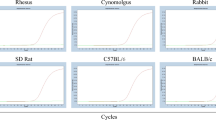Abstract
Xenotransplantation of human cells into immunodeficiency mice has been frequently used to study stem cells in tissue repair and regeneration and cancer cell metastasis. However, a sensitive and reproducible method to quantify cell engraftment lacks. Here, we developed a Real-Time PCR-based method which facilitated consistent detection and quantification of small amounts of human cells distributed in mouse organs after infusion. The principle of the method was to directly detect a humans-specific sequence in the human-murine genomic DNA mixture. In a mouse myocardial infarction model, the Real-Time PCR-based method consistently determined the amounts of human mesenchymal stem cells (hMSCs) engrafted into the heart and other organs 7 days after infusion of as little as 2.5 × 105 cells, indicating a high sensitivity, and the amounts of hMSCs detected in mice highly correlated to the numbers of hMSCs transplanted. Importantly, different from previous PCR-based methods, our method produced highly consistent and reproducible results. The reliability of the method was further proven by parallel analyses of DiI-labeled hMSCs in tissue sections and in single cell suspensions of mice. Our data show that the present human genomic DNA-specific primers-based Real-Time PCR method is sensitive and highly reproducible in determining the amount of xenotransplanted human cells in murine tissues.





Similar content being viewed by others
References
McDermott, S. P., Eppert, K., Lechman, E. R., Doedens, M., & Dick, J. E. (2010). Comparison of human cord blood engraftment between immunocompromised mouse strains. Blood, 116, 193–200.
White, Y. A., Woods, D. C., Takai, Y., Ishihara, O., Seki, H., & Tilly, J. L. (2012). Oocyte formation by mitotically active germ cells purified from ovaries of reproductive-age women. Nature Medicine, 18, 413–421.
Lu, X., Mu, E., Wei, Y., et al. (2011). VCAM-1 promotes osteolytic expansion of indolent bone micrometastasis of breast cancer by engaging alpha4beta1-positive osteoclast progenitors. Cancer Cell, 20, 701–714.
DeRose, Y. S., Wang, G., Lin, Y. C., et al. (2011). Tumor grafts derived from women with breast cancer authentically reflect tumor pathology, growth, metastasis and disease outcomes. Nature Medicine, 17, 1514–1520.
Wu, Y., Ip, J. E., Huang, J., et al. (2006). Essential role of ICAM-1/CD18 in mediating EPC recruitment, angiogenesis, and repair to the infarcted myocardium. Circulation Research, 99, 315–322.
Wu, Y., Chen, L., Scott, P. G., & Tredget, E. E. (2007). Mesenchymal stem cells enhance wound healing through differentiation and angiogenesis. Stem Cells, 25, 2648–2659.
Fisher, R. A., & Mas, V. R. (2009). Cell transplant techniques: engraftment detection of cells. Methods in Molecular Biology, 481, 97–105.
Horie, M., Sekiya, I., Muneta, T., et al. (2009). Intra-articular injected synovial stem cells differentiate into meniscal cells directly and promote meniscal regeneration without mobilization to distant organs in rat massive meniscal defect. Stem Cells, 27, 878–887.
Wang, L. J., Chen, Y. M., George, D., et al. (2002). Engraftment assessment in human and mouse liver tissue after sex-mismatched liver cell transplantation by real-time quantitative PCR for Y chromosome sequences. Liver Transplantation, 8, 822–828.
Nitsche, A., Becker, M., Junghahn, I., et al. (2001). Quantification of human cells in NOD/SCID mice by duplex real-time polymerase-chain reaction. Haematologica, 86, 693–699.
Becker, M., Nitsche, A., Neumann, C., Aumann, J., Junghahn, I., & Fichtner, I. (2002). Sensitive PCR method for the detection and real-time quantification of human cells in xenotransplantation systems. British Journal of Cancer, 87, 1328–1335.
Schneider, T., Osl, F., Friess, T., Stockinger, H., & Scheuer, W. V. (2002). Quantification of human Alu sequences by real-time PCR–an improved method to measure therapeutic efficacy of anti-metastatic drugs in human xenotransplants. Clinical & Experimental Metastasis, 19, 571–582.
Kim, J., Yu, W., Kovalski, K., & Ossowski, L. (1998). Requirement for specific proteases in cancer cell intravasation as revealed by a novel semiquantitative PCR-based assay. Cell, 94, 353–362.
Eckhardt, B. L., Parker, B. S., van Laar, R. K., et al. (2005). Genomic analysis of a spontaneous model of breast cancer metastasis to bone reveals a role for the extracellular matrix. Molecular Cancer Research, 3, 1–13.
Li, Z., Liu, C., Xie, Z., et al. (2011). Epigenetic dysregulation in mesenchymal stem cell aging and spontaneous differentiation. PLoS One, 6, e20526.
Smith-Ravin, J., England, J., Talbot, I. C., & Bodmer, W. (1995). Detection of c-Ki-ras mutations in faecal samples from sporadic colorectal cancer patients. Gut, 36, 81–86.
Larguinho, M., Santos, H. M., Doria, G., Scholz, H., Baptista, P. V., & Capelo, J. L. (2010). Development of a fast and efficient ultrasonic-based strategy for DNA fragmentation. Talanta, 81, 881–886.
Wu, Y., & Zhao, R. C. (2012). The role of chemokines in mesenchymal stem cell homing to myocardium. Stem Cell Reviews, 8, 243–250.
Acknowledgments
This work was supported by grants from Natural Science Foundation of China (No. 30871273, 30971496, U1032003) and The “863 Projects” of Ministry of Science and Technology of PR China (No. 2011AA020118) to Y Wu.
Conflicts of interest
The authors declare no potential conflicts of interest.
Author information
Authors and Affiliations
Corresponding author
Additional information
Pengyue Song and Zhenhua Xie contributed equally to this work
Rights and permissions
About this article
Cite this article
Song, P., Xie, Z., Guo, L. et al. Human Genome-Specific Real-Time PCR Method for Sensitive Detection and Reproducible Quantitation of Human Cells in Mice. Stem Cell Rev and Rep 8, 1155–1162 (2012). https://doi.org/10.1007/s12015-012-9406-3
Published:
Issue Date:
DOI: https://doi.org/10.1007/s12015-012-9406-3




